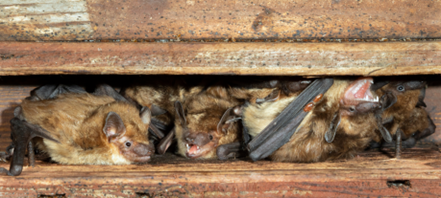
As the snow melts and the days lengthen, Colorado residents might notice more than just the return of warm weather and blooming flowers. Spring marks the beginning of the roosting season for many bat species, a natural process that can lead to close encounters with these winged inhabitants, particularly in the cozy confines of our attics and barns.
Understanding Bats
Bats are a crucial part of Colorado’s ecosystem, essential in controlling insect populations and pollinating plants. Colorado is home to 18 bat species, including the Little Brown Bat (Myotis lucifugus) and the Big Brown Bat (Eptesicus fuscus), known to roost in human structures. Bats inhabit all types of environments throughout the state, ranging from the eastern plains and lofty mountain woodlands to the western deserts and even in urban areas from countryside villages to the heart of Denver. They play a crucial role in pollinating flora and agricultural produce and managing insect numbers, as all species of bats in our region consume insects.
Why Bats Choose Attics
Attics offer a warm, sheltered environment for bats to roost, breed, and rear their young. These spaces mimic the natural cavities found in trees, providing a perfect substitute for bat colonies. During spring, female bats seek out safe places to form maternity colonies and give birth, making attics an attractive option.
If a single bat enters a building, often it’s because a door or window was left open. Typically, the bat will exit on its own if there’s an open window or door. Should the bat remain indoors, you can gently capture and release it with these steps:
- Wear leather gloves, wait for the bat to land, then cover it with a small container.
- Insert a piece of cardboard between the container and the wall, allowing the bat to fall into the container.
- Release the bat outside, ideally near trees or shelter.
Identifying a Bat Infestation
A bat colony in your house can pose a significant health risk to humans and domestic animals, and the noise and odors from a large group can be bothersome. Such colonies often represent maternity roosts. Convincing these bats to vacate can be challenging, as common deterrents like mothballs and ultrasonic devices are ineffective. Moreover, using pesticides or poisons against bats is illegal, as this could lead to dead bats decomposing within your home and increase the risk of exposure to humans and pets. The signs of a bat infestation include:
- Noises: Scratching, squeaking, or crawling sounds in walls or attics, especially at dusk or dawn.
- Guano: Bat droppings resemble mouse droppings but are larger and contain insect parts.
- Stains: Grease marks where bats enter and exit, along with urine stains on walls or insulation.
- Odor: A strong, musky odor from bat guano and urine.
While bats play a beneficial role outdoors, they may cause health risks inside your home. Bat guano can harbor the fungus that causes histoplasmosis, a respiratory disease. Moreover, although rare, bats can carry rabies, a risk to humans and pets if bitten.
Preventing and Managing Bat Infestations
If bats have already taken up residence, consider hiring a pest control professional specializing in humane bat removal, such as Front Range Pest. We can implement exclusion methods that allow bats to leave but prevent them from returning without harming them. Excluding bats, especially maternity roosts, is best done in late summer or fall to ensure the young bats can independently forage.
Pre-Spring Bat Inspection & Exclusion:
- Check your attic: Look for entry points, such as cracks or holes in the roof, vents, or eaves.
- Inspect the entire building: Seach for entry points, such as chimneys, vents, and gaps in soffits or joists, and look for signs like staining or bat droppings that indicate entrances.
- Conduct observations: At dusk to see where bats enter/exit the building.
- Monitor Active Entrances: Over several evenings to gauge the size of the bat colony.
- Install One-Way Bat Exclusion Devices: At entrance points, allowing bats to leave but preventing their return.
- Make Needed Repairs: Seal up all other potential entry points near the exclusion sites, including gaps larger than ¼ inch.
- Keep the exclusion devices in place for at least a week to ensure all bats have exited.
- Remove the devices and permanently seal the entry points.
- Maintain the property by trimming tree branches away from the house to limit access.
Coexisting with Bats
It’s important to remember that bats are protected under Colorado law and benefit the environment. Any attempt to remove or deter bats must be humane and comply with state regulations. Consider creating a bat-friendly environment on your property, such as installing a bat house. This can provide bats with an alternative roosting spot away from your home while allowing them to continue their vital role in the ecosystem. As spring approaches in Colorado, being mindful of our winged neighbors and taking proactive steps can ensure a peaceful coexistence. By understanding bats’ habits and needs, we can appreciate their role in our environment while keeping our homes safe and healthy.
If you suspect bats in your home or office, contact Front Range Pest for humane and effective removal.
Front Range Pest is your trusted, family-owned pest and wildlife control company serving central Colorado and southern Wyoming. Our certified technicians have the expertise and credentials to ensure effective pest management for your home or business. As your all-in-one insect and wildlife specialists, we offer peace of mind by identifying wildlife entry points, removing nuisance pests, sealing access areas, performing cleanup, and making essential repairs. Schedule an inspection with us today.
Written by the digital marketing team at Creative Programs & Systems: www.cpsmi.com